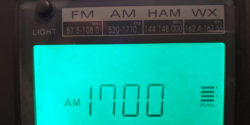Thanks to our intrepid and loyal readers I’ve learned a bit more about the mystery signal I reported on last week.
To recap, I DX’d a station at 1700 AM – a frequency with very few stations assigned across the continent – that simply played 80s pop music, with station IDs that were difficult for me to suss out, though they seemed to be in Spanish. I surmised it to be XEPE-AM in Tecate, Mexico.
Two readers emailed to confirm my identification. Eric, who lives north of me in Lake Stevens, WA, wrote that, “XEPE on 1700 kHz does indeed play English pop songs, especially from the ’80s or so, when it needs to fill time between the Spanish language talk shows. I was confused the first time I heard that as well.”
Chris, a “a fan of casual DXing AM,” shares his journey:
I checked that frequency right away to see what was there. (I am in Pleasanton, near the SF Bay Area of California.) Being only about 4:00pm or so at the time, there was nothing to hear, no surprise there…
Later, my wife and kids and I drove out to a park at about 9:00pm to try to see the Neowise comet, and on the way I told them I wanted to try the station I read about. They know I like to find oddball AM stations and the kids (11 y.o. twins) “allowed” me a minute away from their pop FM stations.
Well, that same station in Tecate made itself apparent, with the Four Seasons’ “Who Loves You” from 1975, clear as a bell. Didn’t even get the whole song in before the kids shut it down, from the rear console of our ‘03 Odyssey, their own little radio command center, but I was satisfied that I had found it. On our way back home, after not seeing the comet, I hit the station again and caught a few crumbs of Carol Douglas doing “Doctors Orders” from 1974.
Chris was later able to tune it in from home on his (Jay Allen approved) Sangean PR-D18. Awoken by his cat a little before 5 AM, he heard the transition from music into talk programming.
Teacher and scholar Sonia Robles authored a book on border radio from the Mexican perspective, “Mexican Waves,” and dropped us a line to assure us, “-honestly- that Mexicans love 80s and 90s US music.”
Of course, we were very excited to hear from Sonia, and have booked her for a forthcoming episode of our radio show and podcast. You can read a review of her book in Humanities and Social Sciences Online.
We also heard from our old friend Tha Dood, who reminded me that a rare breed of AM pirates like to use 1700 and 1710 AM, for two reasons. First, these frequencies are relatively clear of licensed stations. 1710, in particular, is reserved for Travelers Information Stations (TIS), operated at low power by state and local governments to provide travel advisories and tourist information.
The other reason is that because these are the highest frequencies on the AM band, they also have relatively short wavelengths, making it a little more efficient to transmit with a shorter antenna. Mind you, the word relative is operative here – 530 kHz AM has a wavelength of 1800 feet, while 1700 kHz AM is 578 feet. Generally speaking, you want your transmission antenna to be like a half or quarter of that length, but could get away with a smaller fraction. (For comparison, 88.1 mHz FM has a wavelength of just 11 feet.)
I’ve never heard an AM (mediumwave) pirate here in the Pacific Northwest, and the ones I’ve seen reported on message boards like HF Underground seem to be primarily on the US East Coast or in Europe. Greece, Turkey and the Netherlands seem to be particular hotspots.
All of this should be an incentive to take a journey to the right end of the AM dial with a decent radio every so often. You never know what you might hear.



